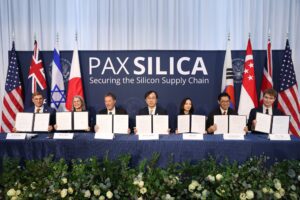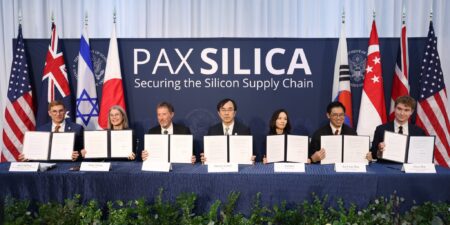
Vietnam Tariff Tracker | July 14, 2025

The BGA Vietnam Team, led by Managing Director Nguyen Viet Ha, wrote an update to clients on trade talks between Vietnam and the United States.
Context
- Vietnamese negotiators have been engaging with their U.S. counterparts to finalize a joint statement and establish a specific tariff schedule. This follows the July 3 call between Trump and Vietnamese Communist Party General Secretary To Lam and Trump’s subsequent social media post announcing tariffs of 20 percent on Vietnamese imports and 40 percent on transshipped goods. Both sides are currently addressing the definition of “transshipping” and rules of origin. Negotiations are ongoing online, and Vietnam is preparing to send a delegation to Washington, D.C., after U.S. officials confirm a meeting schedule.
- Vietnam is continuing its efforts to revise regulations on the origin of goods. A draft decree concerning rules of origin has been submitted to the Ministry of Justice for evaluation. The draft introduces a risk-based methodology to issue certificates of origin and aims to strengthen measures against origin-related fraud. It streamlines an earlier version from May, with certain regulations set to be addressed in a forthcoming circular from the Minister of Industry and Trade to allow greater flexibility. The Ministry of Industry and Trade will amend the draft based on feedback from the Ministry of Justice before submitting it to the government for final approval.
Significance
- Vietnam continues to make progress on addressing nontariff barriers. In the course of revising the personal data law, the drafting authority proposed to eliminate requirements that foreign entities store Vietnamese customers’ data and establish a commercial presence in Vietnam under certain circumstances. This would resolve a regulatory hurdle that has been in place since 2018. Moreover, the Ministry of Finance has proposed extending preferential environmental protection tax rates for gasoline, oil, lubricants and grease products through the end of the year. The proposal is intended to reduce costs in the manufacturing sector, mitigate the effects of energy supply chain disruptions caused by geopolitical factors and support overall economic performance.
- Trump issued letters to 22 countries the week of July 7, outlining new tariff rates between 20 percent and 50 percent. He also stated his intention to impose 50 percent tariffs on copper-based goods by August 1 — the new deadline for trade negotiations. Additionally, the president on July 11 announced plans to impose blanket tariffs of 15 percent or 20 percent on most trading partners, noting that he does not expect these measures to significantly impact inflation. Vietnam has not yet received a letter indicating its new tariff rate. A joint statement is expected to be released as both sides work on a bilateral agreement that will list the tariffs for specific product categories.
Implications
- Vietnam’s economy recorded a strong growth for the first half of the year despite tariff concerns. The GDP grew 8 percent in the second quarter, raising year-on-year economic growth for the first six months to 7.5 percent — its highest since 2011. The service sector, which includes foreign trade, transportation, tourism and logistics, grew 8.1 percent year on year and contributed 52.2 percent to total economic growth. The industrial and construction sectors grew 8.3 percent, accounting for 42.2 percent of the country’s overall growth. Manufacturing and processing was the fastest-growing industry at 10.1 percent, although it contributed just 2.6 percent to Vietnam’s overall economic growth. In the first half of the year, Vietnam recorded an export turnover of $219.8 billion, representing a 14.4 percent year-on-year increase. Imports rose 17.9 percent to $212.2 billion, resulting in a trade surplus of $7.6 billion during the same period. Major export categories included computers and electronic devices, apparel, wood and wooden products and seafood, which are key exports to the U.S market.
- Foreign investors remain committed to long-term investments in Vietnam, considering the preliminary Vietnam-U.S. trade deal manageable and better than expected. The announcement of a 20 percent tariff on Vietnam had a positive impact on the country’s stock market. The VN Index climbed to 1,445 July 10 — its highest point since April 2022. Key sectors such as banking, consumer goods and retail saw gains, driven by optimism about a potential trade deal with the United States. Experts expect the rally to continue, with the VN Index possibly reaching 1,480 soon.
We will continue to keep you updated on developments in Vietnam. If you have any comments or questions, please contact BGA Vietnam Managing Director Nguyen Viet Ha at vietha@bowergroupasia.com
Best regards,
BGA Vietnam Team

Nguyen Viet Ha
Managing Director
Ha is a highly respected Vietnamese lawyer, with special expertise in financial transactions, mergers and acquisitions, as well as general business, trade and investment-related issues. Before joining BGA as managing director for Vietnam, Ha managed the Vietnam operations of BrooksBowerAsia for three years. She built and led the Vietnam team and serviced clients in various sectors ranging from energy and ICT to healthcare, logistics and consumer production. Ha practiced law in Vietnam in the 1990s, providing legal advice and consulting services to Fortune 500 clients. She also participated in drafting a number of laws and regulations, including the Foreign Investment ... Read More
×























